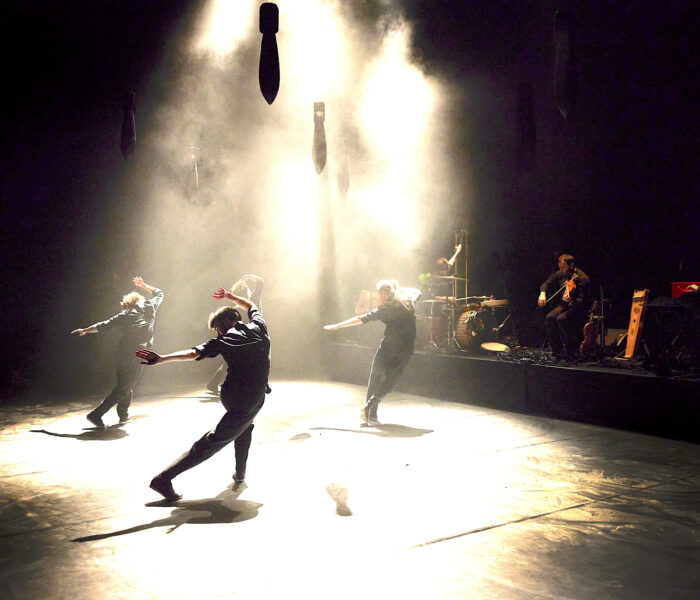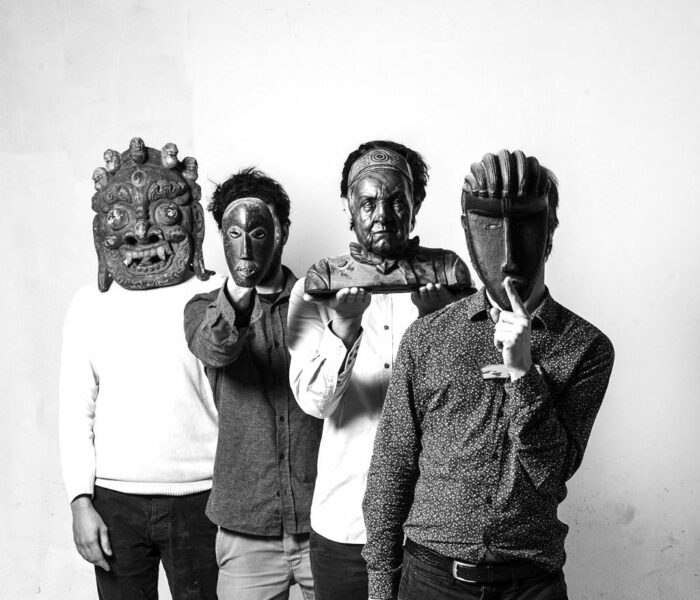En ce jour de février 2023, Bastien Gallet est à Rio de Janeiro et le carnaval, quelques jours avant son ouverture officielle, a déjà envahi la cité brésilienne. D’origine portugaise, cette fête qui annonce le carême réunit chaque année plus de 50 000 personnes venues voir les écoles de samba défiler au Sambodroma et accompagner les blocos de rue qui arpentent la ville en chantant et en dansant. Si sa forme actuelle date des années 1930, le carnaval hérite de traditions beaucoup plus anciennes – africaines, européennes et amérindiennes – dont il est parvenu à opérer une éclatante synthèse.
Ce dimanche matin, rue du Jardin Botanique, les sons de Rio se sont tus. Quelques habitants promènent leur chien. Les voitures circulent ailleurs, détournées à l’orée de la rue par la police de la ville. Il suffit de marcher un peu, cependant, pour apercevoir les premiers signes. Un groupe de cariocas costumés, une rumeur au loin faite de basses, de caisses claires et de voix saturées. L’ambiance vient de changer. Deux cents mètres après le Jardin Botanique, on devine le camion depuis le toit duquel chanteurs, maîtres de cérémonie et première bateria s’adressent à une foule déjà dense. Plus nous approchons, plus nous sentons la présence envahissante du bloco de rue. Bientôt, tous les autres sons auront disparu, couverts par la masse de ses percussions : tambours (surdos et repiniques), caisses claires, tambourins, chocalhos (petites cymbales), agogôs (cloches à deux tons) et cuicas (tambours à tige). Son nom est Suvaco de Cristo, les aisselles du Christ. Il faut prendre l’expression dans sa littéralité : qui lève les yeux depuis la rue du Jardin Botanique voit, tout en haut du Corcovado, se dresser la statue du Christ Rédempteur, emblème de Rio. Le bloco défile sous ses aisselles, ce qui s’entend doublement : comme une blague d’inversion carnavalesque, le Christ transpire avec nous qui marchons sous lui, mais aussi comme un rite de protection, si vous voyons ses aisselles, c’est parce qu’il a étendu ses bras et que nous défilons sous ses ailes, dont une marche célèbre, entonnée à chaque Carnaval, demande qu’elles s’ouvrent pour celui ou celle qui désire passer (Ó abre alas / Que eu quero passar)*, entrer dans la danse et dans la fête ou de vie à trépas.
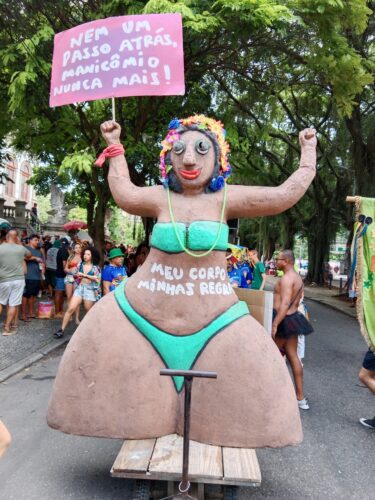

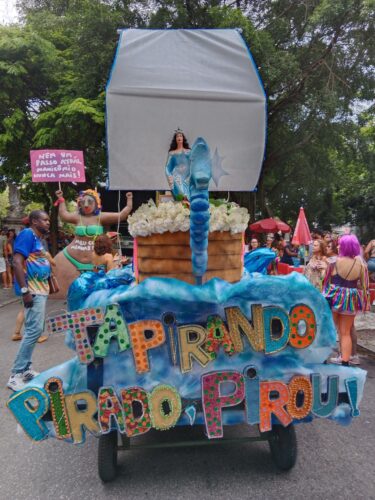
Ce dimanche 12 février, cinq jours avant l’ouverture officiel du Carnaval, les rues de Rio appartiennent à Suvaco de Cristo, au Cordão do Boitatá, au Carrossel de Emoções (Carrousel des émotions), aux Tambores de Olokun, à Acorda e Vem Brincar (Réveillez-vous et venez jouer), à Vai Tomar no Grajaú, à Fogo e Paixão (Feu et passion), à Tá Pirando, Pirado, Pirou! (bloco conçu par et en partie composé de patients de l’hôpital psychiatrique Philippe Pinel), etc., pour ne citer que quelques-uns d’entre eux. On compte à Rio plus de deux-cent-cinquante blocos de rue pour environ soixante-dix écoles de samba. Ces dernières défilent dans la rue à double gradin du Sambodrome Marquês de Sapucaí, un monument imaginé dans les années 1980 par le gouverneur de Rio et dessiné par Oscar Niemeyer pour faire du Carnaval à la fois le spectacle et la vitrine de la ville et du Brésil. Chaque année les écoles rivalisent d’art et de virtuosité pour remporter le prestigieux concours de Samba de Erendo, que l’on peut traduire par samba à thème ou à récit. La composition de ce récit musical et du spectacle qui l’accompagne est le travail d’une année entière qui trouve son accomplissement fin février dans l’allée du sambodrome.
Les blocos de rue défilent dans la ville, sans public sinon ceux qui se joignent à la procession, mais également sans autres contraintes que de marcher en musique. On ne saurait cependant opposer le spectacle des écoles de samba à la liberté des blocos. Si la construction du sambodrome fut certainement une manière pour le pouvoir politique de normaliser la pratique du carnaval, cela n’a jamais empêché les écoles, qui sont installées dans les quartiers populaires de Rio et sont composées en majorité d’afro-brésilien.ne.s , de politiser leur enredo. Ainsi, en 2019, la Mangueira remporta-t-elle le concours avec une samba qui célèbre l’histoire de celles et ceux que l’État brésilien ou ses milices ont réduit.e.s au silence, de Luìsa Mahin à Dandara dos Santos et Marielle Franco (assassinées en 2017 et en 2018), un chant qui est devenu un des hymnes du Carnaval**.
Je suis arrivé à Rio le 5 février pour participer à un bloco de rue, Panamérica Transatlântica, né en 2019 en réaction à l’élection de Jair Bolsonaro à la présidence du Brésil et à l’initiative de l’artiste chilienne Viviana Mendez et du cinéaste et poète brésilien Dado Amaral. Un bloco panaméricain et transatlantique, composé de Brésilien.ne.s, de Français.e.s, de Chilien.ne.s, d’Argentin.e.s, d’Espagnol.e.s, etc., une étrange et disparate communauté réunie par un projet et un désir. Cela fait trois ans que nous n’avons pas défilé et quelques mois que Bolsonaro n’est plus au pouvoir. Le 20 février, nous partirons de la Praça de Harmonia, dans le centre de Rio, où nous reviendrons, si tout va bien, quelques heures plus tard.
J’ai dit que nous étions réuni.e.s par « un projet et un désir » mais il est vrai qu’en 2019 mon désir était bien vague, moi qui ignorais tout du Carnaval. Ce désir, il a fallu le construire collectivement, en faire un projet commun et tri-lingual. Nous nous sommes surtout rendu compte que le Carnaval était une étrange et très puissante publicité du désir au sens où il consiste à rendre publique ce que l’ordre social tend à dissimuler ou à interdire : les corps et leur peau, leurs danses, leur toucher, leurs baisers, etc. Ce qui ne va pas sans toute une mise en scène, en musiques, en récits, en costumes, en maquillages et en parures, en scénographies diverses et mobiles, ce qu’on pourrait appeler un agencement au sens obvie où un bloco ne fonctionne qu’à agencer ensemble tous ces éléments et à les mettre en marche. Car un bloco, qu’il soit officiel ou officieux, de sambodrome ou de rue, désire en avançant, et en avançant s’approprie ce qu’il ne saurait posséder, la ville.
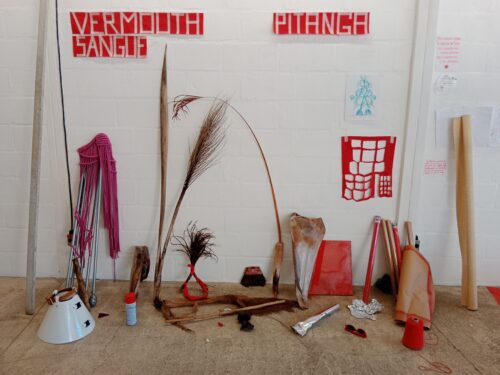
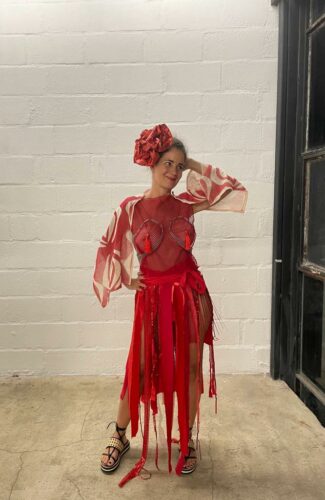

I
l faut avoir suivi le Cordão do Boi Tolo du centre de Rio à la plage de Lemme, à travers tous les quartiers sud, de Lapa à Flamengo, jusque dans le tunnel routier qui relie Botafogo à la ligne des plages, que le bloco bloque allègrement pendant des heures avant de remonter en s’étirant sans fin de Lemme à Copacabana, pour comprendre la singulière puissance de ces milliers de corps qui ne font que marcher en dansant et danser en chantant.
Bastien Gallet
* Marchinha composée et écrite en 1899 par la compositrice et musicienne brésilienne Chiquinha Gonzaga. Les ailes du premier vers désignent les sections de danseurs et de musiciens qui sont à la tête du défilé et qui ici s’ouvrent pour laisser passer la narratrice.
** “Histórias Para Ninar Gente Grande” (Histoire pour endormir les grandes personnes). Le troisième couplet dit explicitement quelle histoire cette samba entend raconter, qui n’est évidemment pas l’histoire officielle.
“Brasil, meu nego
Deixa eu te contar
A história que a história não conta
O avesso do mesmo lugar
Na luta é que a gente se encontra”
« Brésil, mon cœur
Laisse-moi te raconter
L’histoire que l’histoire ne raconte pas
L’envers du même pays
C’est dans la lutte qu’on se rencontre »



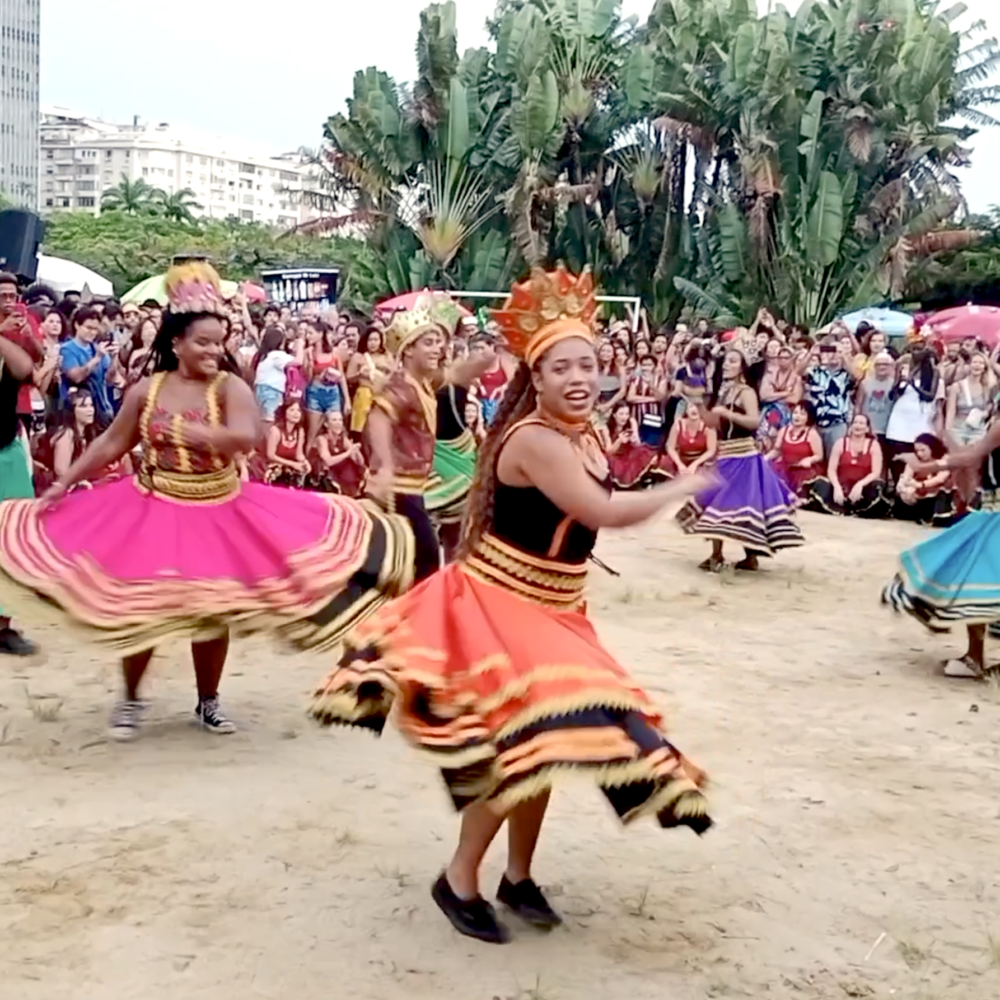)

